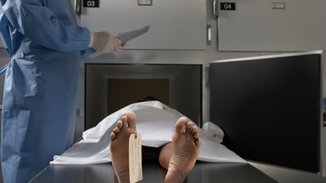Forensic entomologists can chemically analyze fly eggs from a corpse, which might speed up detective work. Christopher Intagliata reports.
法医昆虫学家能够利用化学方法分析尸体中的苍蝇卵,这能加速侦探工作的进行。克里斯托弗·因塔利亚塔报道。
撰文/播音:克里斯托弗·因塔利亚塔(Christopher Intagliata)
翻译:郭鑫鹏
审校:郭晓
As soon as a person dies, decomposition begins. And the first visitors arrive. "Within five to 15 minutes of death, blowflies or other insects begin to colonize the body." Rabi Musah, an organic chemist at the University at Albany.
一个人死亡之后,尸体就会开始腐烂。这时,第一批拜访者就到了。“在人死后的5到15分钟内,绿头苍蝇和其他昆虫便开始在尸体中繁殖。”奥尔巴尼大学有机化学家拉比·姆沙(Rabi Musah)说。
She says different species turn up at different stages of decomposition. "Because of that, depending on what entomological evidence you find, you can learn something about when the person died in terms of the timing of the death."
她说不同的物种会在腐烂的不同阶段出现。“正因如此,根据你发现的昆虫证据,你就可以了解到这个人的死亡时间信息。”
Flies don't tend to stick around when disturbed—by detectives, for example. But they do leave behind eggs. The eggs are hard to tell apart by appearance alone, so forensic entomologists rear them until they hatch, a few weeks later—getting a species ID and, with a little guesswork, a person's time of death.
在如侦探的干扰下,苍蝇不会在尸体周围逗留,但是它们会留下卵。这些卵很难通过外表区分,所以法医昆虫学家将它们培养至孵化,这大约需要几周时间——然后便能得知物种ID,并推测出一个人的死亡时间。
But Musah has come up with a less time-intensive approach: chemical analysis of the eggs. She and her team investigated that method by first harvesting flies with pig-liver traps stashed throughout New York City. "So it turns out that it's easy to hide pig livers in various parts of Manhattan. There's a lot of foliage and whatnot, so no one knew."
但是姆沙提出了一个耗时更少的方法:对这些卵直接进行化学分析。为了探究该方法是否可行,她和其团队首先在纽约城中藏匿了一些猪肝,然后通过这些猪肝陷阱来收集苍蝇。“我们发现在曼哈顿各处藏一些猪肝很简单。因为这里有很多植物和其他东西,所以没人会知道。”
They collected the trapped flies and then chemically analyzed their eggs. And it turns out each species of fly egg has a unique chemical fingerprint—enough to tell the bugs apart without raising the eggs to maturity. And in a useful twist, the technique uses eggs preserved in alcohol—eggs that wouldn't be viable for rearing live insects anyway. The study is in the journal Analytical Chemistry. [Justine E. Giffen et al., Species Identification of Necrophagous Insect Eggs Based on Amino Acid Profile Differences Revealed by Direct Analysis in Real-Time High-Resolution Mass Spectrometry]
他们收集这些捕获的苍蝇,然后对它们的卵进行化学分析。结果表明,每个物种的苍蝇卵都有其独特的化学指纹——这足以让我们在不经过孵化的情况下识别出这些虫子。一个意外好处是,这个技术利用的是保存在酒精中的虫卵,这就意味着这些虫卵无论如何也不能孵化成活体昆虫。这项研究发表在期刊《分析化学》上。
Musah and her colleague Jennifer Rosati are now testing the method on a real case. "And once we do that we will be publishing some case studies to illustrate that this is a method that can be used, and hopefully eventually it's something that will stand up in court."
姆沙和她的同事詹妮弗·罗莎蒂现在正在实际案例中测试这个方法。“一旦我们完成了,我们会发表一些案例研究来说明这个方法确实有效,我们希望它最终能成为在法庭上站得住脚的证据。”
And something that could speed up detective work—or help revive a cold case.
而且这个方法还能帮助加速侦探工作——或解决悬案。
—Christopher Intagliata

 京公网安备11010502039775号
京公网安备11010502039775号  京公网安备11010502039775号
京公网安备11010502039775号 
















